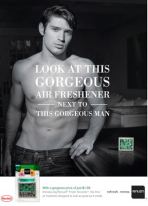My last two posts have mainly centered on just how females are poorly represented by the media and how society is influenced by this falsified version. So what about our male counterparts? Why is it that there is far less of a focus on males in advertising? Is advertising with males simply less prominent than it is with females? Are males influenced less by advertising?

One such post on Adweek states how the objectification of men in advertising is nothing new. Icons such as the Old Spice man or the Marlboro man have been around for a very long time (AdWeek, 2015). Yet, more recently there has been an explosion in the often…shall we say…shirtless stud. These individuals are involved with everything from colognes to air fresheners. Yep, air fresheners. In the advertisement just here, really the model has been plonked in for no particular reason. Although many ad experts and social commentators see the whole thing as a harmless turning of the tables following decades of bikini-clad babes in beer commercials, I’m not quite sure its all that simple. Simply because men are now objectified more frequently than ever by the media could be wrongly seen as equality.However, this really isn’t the case. The real argument is how the media has become more of an equal opportunity discriminator. Men’s bodies simply are not good enough now either. This notion has been argued by “The Atlantic” which stated how; “In the face of the ideals they’re bombarded with, its no surprise that adolescent boys, like wave of girls before them, are falling prey to a distorted image of themselves and their physical inadequacies” (The Atlantic, 2014). Thus, it is now safe to say that the impact of such images are also having an impact and the impact of such is real. Recent research has found a significant relationship between men’s exposure to the muscular ideal portrayed by media and negative self-images. One again the effect that media can have on our own self-image and self-worth is really shocking. The correlation between the unrealistic ideal offered by the media and the real life impact it has on us is prominent here too. However, unlike their female counterparts, its not about getting skinny, its about bulking up.
Now more than ever, males are told that they need to be bigger to “fit” with the conformity of the muscular ideal. Research conducted found that up to 25% of normal weight males consider themselves to be underweight (McCreary and Sadava, 2001). Thus, media images have distorted our perceptions of reality and of what is normal.
Again, advertisers of all kinds have copped onto this notion and are preying on what we have come to accept as normal. Marketers are targeting an ever younger age group so as to rope them in. Figurines of action heroes, for example, have lost all fat but now carry a substantial six pack. Even action children s Halloween costumes have added padding to make them bigger (The Atlantic, 2014).The point is that from an ever younger age, males are getting the message that they will need to resemble such. It is also now more prominent in high schools according to The Atlantic. This article argues how a 2012 study conducted found that muscle enhancing foods like protein rich sports bars and protein shakes are “pervasive” amongst such a young age group.
Thus, it has become clear that the impact of media advertising is now having the same negative impact on males, just as it has done with females, and although almost catching up, the impact is the same. Adverts have an alarming amount of control on forming our “own” self-images and self-worth.
Readings:
AdWeek, (2015). Hunkvertising: The Objectification of Men in Advertising. [online] Available at: http://www.adweek.com/news/advertising-branding/hunkvertising-objectification-men-advertising-152925 [Accessed 18 Feb. 2015].
The Atlantic, (2014). Body-Image Pressure Increasingly Affects Boys. [online] Available at: http://www.theatlantic.com/health/archive/2014/03/body-image-pressure-increasingly-affects-boys/283897/ [Accessed 18 Feb. 2015].
McCreary, D. and Sadava, S. (2001). Gender differences in relationships among perceived attractiveness, life satisfaction, and health in adults as a function of body mass index and perceived weight.Psychology of Men & Masculinity, 2(2), pp.108-116.

Have you seen the documentary called Miss Representation? It’s about female representation in advertising, politics and business. Absolutely eye-opening. I think you’d like it.
LikeLike
No I haven’t! Thanks so much for the recommendation.
LikeLike